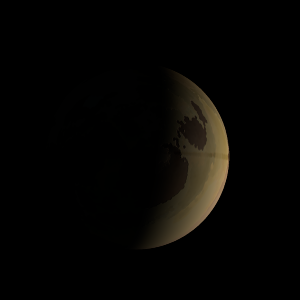|
|
Space Astro
|
Info for exoplanet "Tenoecal Jarn"
| Scientific (actual) data |
|---|
| Name | Kepler-189 b |
| Planet status | Confirmed |
| Radius | 0.108 |
| Orbital period | 10.3999 |
| Semi major axis | 0.088 |
| Discovered | 2014 |
| Updated | 2021-02-05 |
| Tconj | 2454970 |
| Impact parameter | 0.23 |
| Publication | Announced on a website |
| Detection type | Primary Transit |
| Alternate names | 2MASS J19101553+4418180 b, K00574.02, KIC 8355239 b, KOI-574 b, KOI-574.02, WISE J191015.51+441818.1 b |
| Star name | Kepler-189 |
| Right ascension | 287.57° |
| Declination | 44.31° |
| Mag j | 13.408 |
| Mag h | 12.941 |
| Mag k | 12.921 |
| Star distance | 601.75 |
| Star metallicity | -0.134 |
| Star mass | 0.79 |
| Star radius | 0.75 |
| Star temperature | 5235 |
| Star alternate names | 2MASS J19101553+4418180, KIC 8355239, KOI-574, WISE J191015.51+441818.1 |
| Wikipedia article | Kepler-189 b |
Back
| |
| Fictional info (?) |
|---|
| Suggested name | Tenoecal Jarn |
| Planet type | Warm planet |
| When viewed from Earth, this proximity to Kepler-189 means the planet can only be seen near the western or eastern horizon during the early evening or early morning.
The largest moon, Galaphaë, has a diameter greater than that of the planet Mars. |
| Atmosphere | Ozone | 44% |
| Methane | 22% |
| Hydrogen | 15% |
| 2H2O | 11% |
| Formaldehyde | 5.1% |
| Hydrogen peroxide | 0.94% |
| Ammonia | 0% |
| Atmospheric pressure | 0.16 bar |
 |
| Moon | Galaphaë | Small slightly egg-shaped rocky comet |
| Siar | Very small irregular oceanic moon |
| Clitis Mede | Huge irregular gaseous asteroid |
| Uqobe Hy | Large round rocky asteroid |
| Aehitur | Small potato shaped oceanic planetoid |
| Google search for Tenoecal jarn |
|
Website by Joachim Michaelis
|
|
|
|